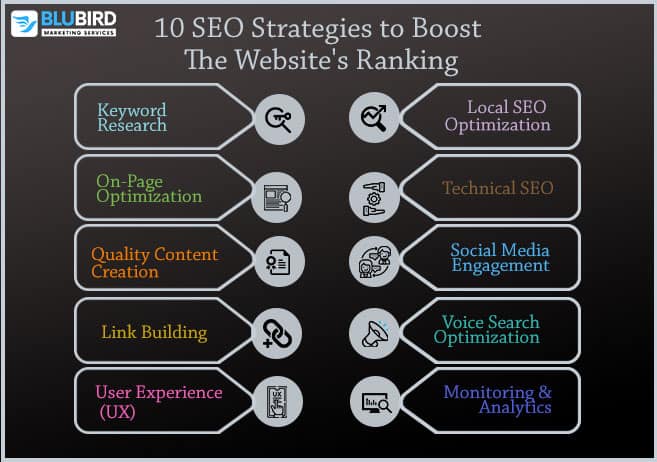In today’s rapidly evolving digital landscape, establishing a robust online presence has become essential for businesses to succeed. With countless websites competing for attention, Search Engine Optimization (SEO) has emerged as a crucial strategy to enhance website visibility and attract organic traffic. It is the practice of enhancing your website in order to improve its visibility and ranking on search engine results pages (SERPs). In this blog, we will discuss 10 effective SEO strategies to boost your website’s ranking and provide you with a comprehensive understanding of each approach.
If you’re looking to improve your website’s ranking on search engines, implementing SEO strategies is crucial. SEO best practices are a set of guidelines that can improve a site’s organic rankings. By following them, you can optimize your website for search engines and improve your visibility.
The Top 10 Proven SEO Strategies to Boost The Website
Here, we’ll explore 10 proven SEO strategies that can help you improve your website’s search engine ranking.

1. Keyword Research:
Keyword research is a crucial aspect of search engine optimization (SEO) and digital marketing strategies. It involves identifying and analyzing the words and phrases that potential users enter into search engines when looking for information, products, or services. Tools like Google Keyword Planner and SEMrush can assist you in finding the optimal keywords for your website.
The primary goal of keyword research is to select the most relevant and high-performing keywords that can drive targeted traffic to a website. By understanding which keywords are popular and how often they are searched, businesses can optimize their website content, improve visibility in search engine results pages (SERPs), and ultimately increase organic traffic.
Effective keyword research involves a combination of analyzing search volume, competition level, and relevance to the business or website’s content. Keyword research tools and software play a significant role in this process, providing valuable insights into keyword metrics and related keyword suggestions.
2. On-Page Optimization:
On-page optimization refers to the set of practices and techniques employed to optimize individual web pages in order to improve their search engine rankings and increase organic traffic. It involves optimizing various elements within a webpage to make it more search engine-friendly and user-friendly.
One of the key aspects of on-page optimization is optimizing the HTML source code. This includes optimizing title tags, meta descriptions, header tags, and URL structures to include relevant keywords and accurately describe the page’s content. Additionally, optimizing the web page’s content by strategically placing keywords, using proper formatting, and ensuring a good user experience helps to enhance its relevance to search engine algorithms.
Other important on-page factors include optimizing images with relevant alt tags, ensuring fast loading times, having a mobile-friendly design, and implementing internal linking between related pages. These elements improve the overall user experience and make it easier for search engines to crawl and index the webpage.
3. Quality Content Creation:
Quality content creation for SEO focuses on producing valuable, relevant, and engaging information that meets the needs and interests of the target audience. It involves conducting thorough keyword research to identify relevant terms and phrases that align with user search intent. Incorporating these keywords naturally throughout the content helps search engines understand what the page is about.
Additionally, quality content should be well-structured, easy to read, and optimized for both users and search engines. This means using descriptive headlines, bullet points, and subheadings to enhance readability. Including multimedia elements like images, videos, and infographics can further enhance the user experience.
By focusing on quality content creation, websites can improve their organic visibility, attract more targeted traffic, and establish themselves as reliable and trustworthy sources of information in their industry
4. Link Building:
Earning high-quality backlinks from authoritative and relevant websites is essential. Seek opportunities to guest post, collaborate with influencers, and engage in social media marketing to increase your website’s visibility and domain authority.
Link building involves acquiring hyperlinks from other websites to your own. These incoming links act as “votes of confidence” for search engines, indicating that your website is a valuable and trustworthy resource. When reputable websites link to yours, search engines view your site as credible and relevant, boosting its search rankings.
To implement a successful link-building strategy, several tactics can be employed. These include creating high-quality content that naturally attracts links, reaching out to relevant websites for partnership opportunities, and guest posting on authoritative platforms. Additionally, networking with influencers and leveraging social media can also help build valuable backlinks.
5. User Experience (UX):
Optimize your website’s user experience to decrease bounce rates and encourage longer visits. Improve site navigation, enhance page load speed, and ensure mobile compatibility. Engaging and intuitive designs along with easy-to-use forms and clear calls-to-action can significantly improve your website’s UX.
Combining SEO and UX can produce significant benefits. When users find your website easily through search engines, they’re more likely to stay longer if the UX is pleasant. This boosts dwell time, reduces bounce rates, and increases the chances of conversions or desired actions. Prioritizing both SEO and UX ensures that your website ranks well in search results and provides a delightful experience, ultimately leading to increased visibility, traffic, and overall success.
6. Local SEO Optimization:
Local SEO optimization refers to the strategies and techniques employed to improve the online visibility and search rankings of a business in local search results. It focuses on attracting potential customers in a specific geographical location.
To optimize local SEO, businesses should start by creating and optimizing their Google My Business (GMB) profile. This includes providing accurate information about the business, such as name, address, phone number (NAP), and business hours. It is crucial to ensure consistency across all online directories and listings.
Furthermore, local businesses should focus on generating positive customer reviews to build credibility and improve search rankings. Encouraging customers to leave reviews on popular review platforms can significantly impact local SEO.
Additionally, earning backlinks from local and authoritative websites can boost local SEO. Collaborating with local influencers or participating in community events can help generate these valuable backlinks.
7. Technical SEO:
Technical SEO refers to the optimization of a website’s technical elements to improve its visibility and ranking on search engine result pages (SERPs). It focuses on enhancing the website’s crawl ability, indexability, and overall user experience. Some key aspects of technical SEO include fixing broken links, website speed optimization, mobile-friendliness, XML sitemaps, robots.txt, canonical tags and improve website security (SSL encryption).
One crucial aspect of technical SEO is ensuring that search engine bots can easily crawl and index website content. This involves optimizing website structure, internal linking, and using XML sitemaps to provide search engines with a clear map of the website’s pages. Additionally, optimizing website speed through techniques like caching, compressing images, and reducing server response time is vital for user experience and search engine rankings.
Moreover, making a website mobile-friendly is essential as mobile searches continue to dominate. Responsive design, optimized images, and mobile-friendly navigation are all crucial for providing a seamless user experience on mobile devices.
8. Social Media Engagement:
Social media engagement is about creating valuable content, sharing it with the right audience, and encouraging interactions such as likes, comments, and shares. This not only helps to build brand awareness but also generates social signals that search engines consider when ranking web pages. Additionally, sharing content on social media platforms increases its visibility, driving more traffic to the website.
Engage actively on social media platforms relevant to your business. Share your content and interact with your audience, building brand visibility and driving traffic back to your website. It is essential to optimize social media profiles by including relevant keywords in the bio, description, and headlines. Additionally, using consistent branding elements like logos and color schemes helps establish a strong online presence.
9. Voice Search Optimization:
Voice search optimization is the process of optimizing websites and content to enhance visibility and relevance for voice-based search queries. With the rapid rise in voice assistant technology, such as Siri, Alexa, and Google Assistant. Voice search has become increasingly popular. Voice search optimization focuses on understanding how people phrase their queries in natural language and tailoring content to align with those patterns.
To optimize for voice search, several key strategies should be implemented. Firstly, it’s crucial to use long-tail keywords that mirror conversational phrases rather than traditional typed queries. Utilizing structured data markup helps search engines comprehend and display information more effectively. It’s also important to create concise and easy-to-understand content that specifically addresses user intent.
10. Monitoring and Analytics:
Monitoring involves regularly checking key metrics and indicators to assess the overall health and performance of your website. This includes tracking keyword rankings, organic traffic, click-through rates, and conversion rates. By monitoring these metrics, you can identify trends, spot issues, and understand how users are interacting with your site.
Analytics, on the other hand, involves analyzing the collected data to gain actionable insights. This includes identifying high-performing keywords, understanding user behavior, and identifying areas for improvement. Through analytics, you can uncover valuable information about your target audience, their preferences, and the effectiveness of your SEO strategies.
Conclusion:
Implementing these 10 SEO strategies can significantly boost your website’s ranking and enhance its visibility in search engine results. Remember that SEO is an ongoing process – stay updated with the latest algorithm changes, adapt your strategies as needed, and analyze the performance regularly. With consistent effort and dedication, you can achieve higher organic rankings and drive increased traffic to your website.





